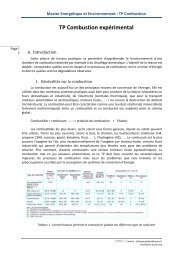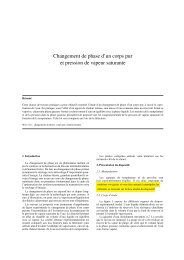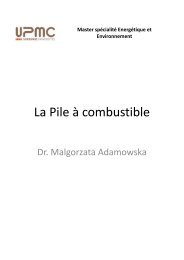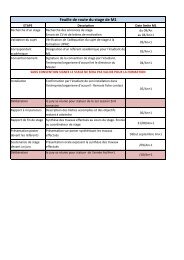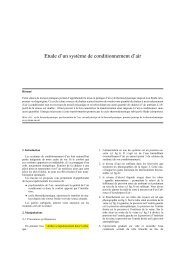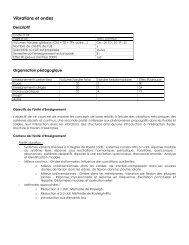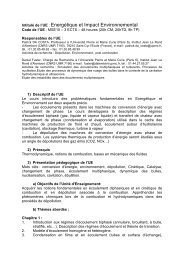PROBLEMS ON MULTIPHASE FLOW Daniel Fuster fuster ...
PROBLEMS ON MULTIPHASE FLOW Daniel Fuster fuster ...
PROBLEMS ON MULTIPHASE FLOW Daniel Fuster fuster ...
You also want an ePaper? Increase the reach of your titles
YUMPU automatically turns print PDFs into web optimized ePapers that Google loves.
<strong>PROBLEMS</strong> <strong>ON</strong> <strong>MULTIPHASE</strong> <strong>FLOW</strong><br />
<strong>Daniel</strong> <strong>Fuster</strong><br />
<strong>fuster</strong>@dalembert.upmc.fr<br />
Phase change<br />
1. We want to vaporize the 10% (in volume) of liquid flowing through a pipe with constant section. The liquid at the<br />
inlet is saturated and its temperature is 150 degrees celsius. The velocity is 10 m/s.<br />
(a) What is the pressure at the inlet?<br />
(b) What is the pressure at the outlet assuming that both fluids, liquid and vapor, are inviscid (no viscosity)?<br />
(c) How much energy per unit surface we have to introduce in the system?<br />
We will assume that the velocity of both phases at the outlet is the same.<br />
Notes:<br />
The equilibrium liquid/vapor line is assumed to be well represented by the Antoine’s equation:<br />
ln p sat<br />
133.322 = A− B<br />
C +T<br />
(1)<br />
where p sat must be given in Pascals, and for water: A=18.3036, B=3816.44K, C=-46.13K.<br />
The enthalpy of vaporization will be assumed to obey the Watson’s formula:<br />
∆H vap = ∆H 0 vap<br />
(<br />
Tc −T<br />
T c −T bp<br />
) 0.38<br />
(2)<br />
where, for water, ∆H 0 vap ≈ 2.2 J/Kg, T c is the critical temperature (647K) and T bp is the temperature of the boiling<br />
point. For simplicity, we will assume that the enthalpy of vaporization at the pressure of operation is approximately<br />
equal to that at 1 atm.<br />
2. Would be possible to vaporize the 100 % of the liquid in problem 1? Why? Obtain the minimum pressure at the<br />
inlet so that we can vaporize all the liquid inside the heat exchanger.<br />
3. We want to cool down 0.1 m 3 /s of liquid at 60 degrees Celsius in a refrigeration tower. To achieve that, we pulverize<br />
the liquid generating a continuous flow of droplets of radius 1 mm.<br />
(a) If we assume that the air surrounding the droplets is dry at every instant, what is the evaporation rate of a<br />
single droplet?<br />
Note: The global mass transfer coefficient is given by the following correlation: Sh = 2+0.6Sc 1/3 Re 1/2<br />
p where<br />
the nondimensional numbers are defined as follows:<br />
Sc =<br />
Re = D pv T ρ air<br />
µ air<br />
( ) 1/3<br />
µ air<br />
ρ air D air/vapor<br />
Sh =<br />
kD p<br />
D air/vapor<br />
The diffusion coefficient of vapor in air is D air/vapor = 2.91 10 −5 m 2 /s and the terminal velocity of a falling<br />
droplet can be obtained as:<br />
√ 2mg<br />
v T =<br />
(3)<br />
ρ air AC d<br />
For simplicity we will use C d = 0.5.<br />
(b) What is the exchange energy rate (in Watts) related to the mass transfer? (we will use ∆H vap ≈ 2.2 J/Kg)<br />
1
(c) What is the height H at which we have to pulverize the droplets if we want the reduce its temperture down to<br />
25 degrees Celsius?<br />
(d) Repeat the calculation considering that the air entering in the system is already saturated with water.<br />
Note: The heat transfer coefficient is obtained using the following correlation: Nu = 2+0.6Re 1/2<br />
p Pr 0.33<br />
(e) Repeat a), b) and c) for droplets of 1cm.<br />
4. We need to condensate 1 m 3 /s of vapor at 250 degrees Celsius and 2 atm that enter in a chamber through a pipe<br />
of section 0.1 m 2 . To achieve that we introduce water at 20 degrees Celsius and 2 atm through a pipe of the same<br />
section and we collect the condensate at the bottom of the chamber aat 25 degrees Celsius and 1 atm.<br />
(a) What is the amount of liquid we need to introduce to condensate the vapor?<br />
(b) If we pulverize droplets of 1 mm, can you obtain the minimum time of residence of the droplet inside the reactor<br />
to accomplish the phase transformation?<br />
(c) Can you propose other methods to condensate the vapor without any flow of liquid?<br />
(d) Obtain the width and the length of a heat exchanger based on film condensation.<br />
5. We inject fuel in a tube at 5 m/s and 10 atm. The liquid jet at the inlet is spherical and its radius is 1 mm. The<br />
fuel is burnt with air injected at 25 degrees celsius and 10 atm. The inlet gas velocity is 30 m/s and the external<br />
radius is 3mm. The geometry is depicted in Figure 5. Assuming that we burn all the liquid,<br />
AIR<br />
FUEL<br />
AIR<br />
(a) Obtain the velocity of the gas at the exit<br />
(b) Calculate the pressure and temperature at the exit<br />
(c) If we inject liquid and gas to the atmosphere at 1 atm, obtain the new temperature of the exhaust gases<br />
assuming that all the energy generated by the combustion is absorbed by the air injected.<br />
We will assume that the heat generated during the combustion is 500 MJ/(kg liquid burnt). The molecular weight<br />
of both liquid and gas is assumed to be approximately equal to 28 kg/mol.<br />
Bubble dynamics<br />
1. Obtain the initial pressure radial distribution in the liquid surrounding a spherical bubble of radius R 0 initially in<br />
equilibrium with a liquid at p 0 after increasing the pressure far from the bubble to p 0 +∆P. We will assume that<br />
the pressure far from the bubble is increased instantaneously. The physical properties of the gas and the liquid are<br />
known (surface tension, viscosity).<br />
Taking the properties for a air/water system, obtain the time of implosion as a function of the bubble radius and<br />
compare it with the time of dissolution at a constant pressure p 0 +∆P. We will assume that the concentration of air<br />
dissolved in the liquid at the interface is in equilibrium and that the air concentration far from the bubble is zero.<br />
Note: The concentration of air in equilibrium is obtained from the Henry’s law: c = Hp, where H is the Henry’s<br />
constant (10 −4 mol/L/atm) and p is the bubble pressure at the interface.<br />
2. We have a recipient full of water at 25 degrees Celsius and 1 atm and we apply a constant heat flux Q. We will<br />
assume the existence of small bubbles in the liquid of radius R 0<br />
(a) Represent the evolution of the temperature of the system with time for different initial radius if the recipient is<br />
openedtotheatmosphere. Wewill assumethat thebubble andthesurroundingliquid arealwaysin equilibrium.<br />
2
(b) In the case above, represent the evolution of the percentage of water vapor contained inside the bubbles with<br />
time<br />
(c) If we close the recipient, represent the trajectory of the system in a P-T diagram. Write the system of equations<br />
that whose solution would allow us to obtain the temporal evolution of the temperature of the system<br />
All the physical properties of the liquid, vapor and gas are assumed to be known<br />
3





